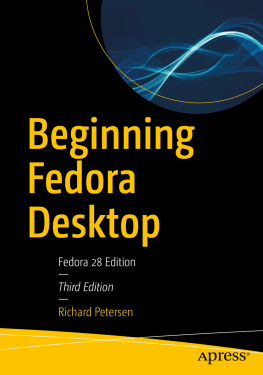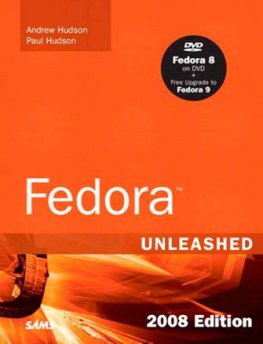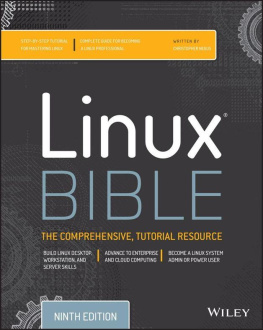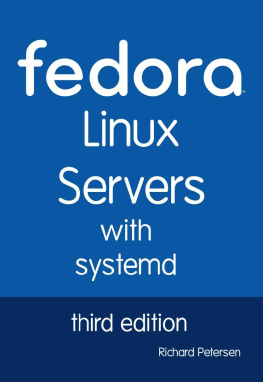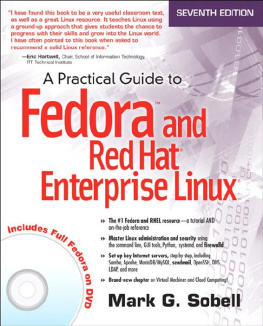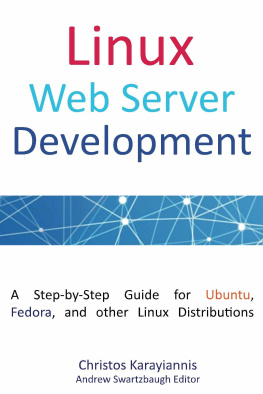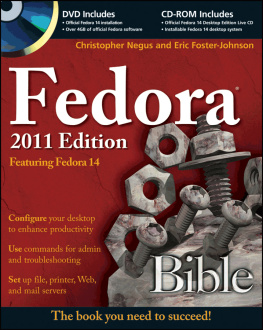Richard Petersen - Beginning Fedora Desktop: Fedora 28 Edition
Here you can read online Richard Petersen - Beginning Fedora Desktop: Fedora 28 Edition full text of the book (entire story) in english for free. Download pdf and epub, get meaning, cover and reviews about this ebook. year: 2018, publisher: Apress, genre: Home and family. Description of the work, (preface) as well as reviews are available. Best literature library LitArk.com created for fans of good reading and offers a wide selection of genres:
Romance novel
Science fiction
Adventure
Detective
Science
History
Home and family
Prose
Art
Politics
Computer
Non-fiction
Religion
Business
Children
Humor
Choose a favorite category and find really read worthwhile books. Enjoy immersion in the world of imagination, feel the emotions of the characters or learn something new for yourself, make an fascinating discovery.
- Book:Beginning Fedora Desktop: Fedora 28 Edition
- Author:
- Publisher:Apress
- Genre:
- Year:2018
- Rating:3 / 5
- Favourites:Add to favourites
- Your mark:
- 60
- 1
- 2
- 3
- 4
- 5
Beginning Fedora Desktop: Fedora 28 Edition: summary, description and annotation
We offer to read an annotation, description, summary or preface (depends on what the author of the book "Beginning Fedora Desktop: Fedora 28 Edition" wrote himself). If you haven't found the necessary information about the book — write in the comments, we will try to find it.
Beginning Fedora Desktop: Fedora 28 Edition — read online for free the complete book (whole text) full work
Below is the text of the book, divided by pages. System saving the place of the last page read, allows you to conveniently read the book "Beginning Fedora Desktop: Fedora 28 Edition" online for free, without having to search again every time where you left off. Put a bookmark, and you can go to the page where you finished reading at any time.
Font size:
Interval:
Bookmark:
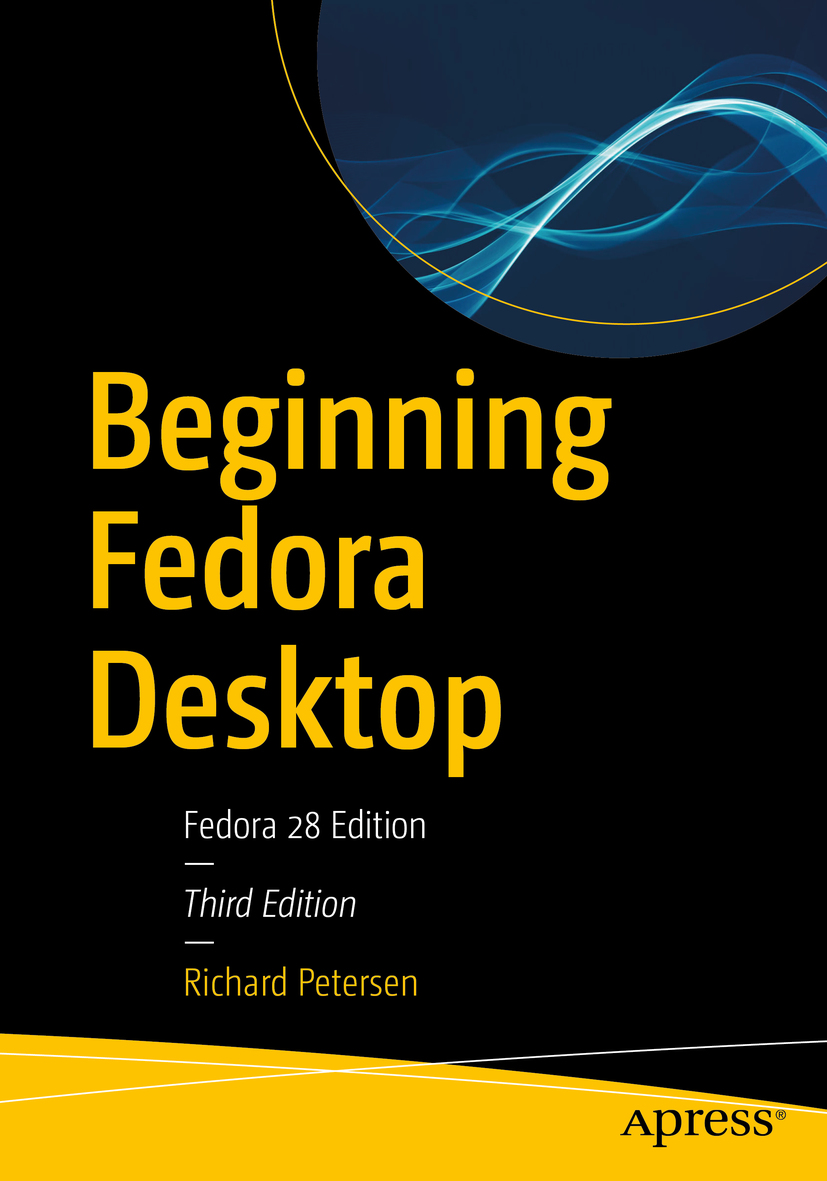

Any source code or other supplementary material referenced by the author in this book is available to readers on GitHub via the books product page, located at www.apress.com/9781484238813 . For more detailed information, please visit http://www.apress.com/source-code .
To my cousins
Carolyn, Maryann, and Gloria
This book examines Fedora Linux 28 for the user. Though administrative tools are covered, the emphasis is on what a user would need to know to perform tasks. The focus here is on what users face when using Fedora, covering topics like installation, applications, software management, the GNOME and Plasma (KDE) desktops, additional desktops such as Cinnamon and Mate, shell commands, and both the Fedora administration and network tools. Desktops are examined in detail, including configuration options. Applications examined include Office Suites, editors, ebook readers, music and video applications and codecs, email clients, Web and FTP browsers, and VoIP and IM applications. This book is designed for the Fedora 28 desktop, with all the latest features of interest to users.
Part I focuses on getting started, covering Fedora information and resources, Fedora Live DVDs, Live USBs, installing and setting up Fedora, and basic use of the desktop as well as device access. The GNOME settings configuration tools such as power, background, screen, network, and display are examined. Also covered is software management using GNOME software, packages, DnfDragora, and the dnf command, along with repositories and their uses, including the RPM Fusion repository.
Part II keys in on applications such as office, mail, graphics, multimedia, Web, FTP, VoIP, IM, and social networking applications. This part includes coverage of the PulseAudio sound interface and music and video applications.
Part III covers the two major desktopsGNOME and Plasma (KDE)discussing the new GNOME 3 features, including the activities overviews, the dash, and the top bar. Unique Plasma features like the dashboard and activities are also explored. In addition, the shell interface is examined, including features like history, filename completion, directory and file operations, among others. Additional desktops are also discussed, including XFCE, LXDE, Mate, LXQT, Sugar (SoaS), and Cinnamon.
Part IV deals with administration topics, first discussing system tools like the GNOME system monitor, the Disk Usage Analyzer, the Disk Utility storage manager, temperature monitors, and the SELinux configuration dialog. Then there is a detailed chapter on Fedora system administration tools, like those for managing users, authorization controls, and Bluetooth, along with service management, file system access, and printer configuration. The network configuration chapter covers a variety of network tasks, including configuration of wired and wireless connections, firewalls, and Samba Windows access.
I would like to thank all those at Apress who made this book a reality, particularly Louise Corrigan, the Apress open source editor who initiated and oversaw the project; Nancy Chen, the coordinating editor; and Jim Markham, the development editor, for their support and analysis, as well as management of such a complex project. I also want to thank Nikolaos Vyzas, the technical reviewer, whose analysis and suggestions proved very insightful and helpful. Special thanks to Linus Torvalds, the creator of Linux, and to those who continue to develop Linux as an open, professional, and effective operating system accessible to anyone.
holds a MLIS in Library and Information Studies (UC Berkeley). He is the author of numerous books on C programming, UNIX, and Linux. Currently he is the publisher for Surfing Turtle Press, specializing on books for Fedora and Ubuntu Linux. His research background includes artificial intelligence applications to information retrieval. He has taught computer science programming and UNIX at UC Berkeley.

is a senior engineer at ProxySQL, where he spends the majority of his time writing Python and C/C++, and providing SRE/MySQL DBA support and automation services. Over the last 15 years, his focus has been on open source software implementation and integration at various organizations, including Accenture, Pythian, and Percona. When he isn't glued to his Linux servers you'll find him at home in Athens with his wife Spyridoula, out fishing with friends, or travelling through random European cities. He takes his coffee very, very seriously.
Font size:
Interval:
Bookmark:
Similar books «Beginning Fedora Desktop: Fedora 28 Edition»
Look at similar books to Beginning Fedora Desktop: Fedora 28 Edition. We have selected literature similar in name and meaning in the hope of providing readers with more options to find new, interesting, not yet read works.
Discussion, reviews of the book Beginning Fedora Desktop: Fedora 28 Edition and just readers' own opinions. Leave your comments, write what you think about the work, its meaning or the main characters. Specify what exactly you liked and what you didn't like, and why you think so.

